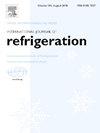Numerical investigation on flow characteristics and working performance in oil-injected sliding vane rotary compressors
IF 3.5
2区 工程技术
Q1 ENGINEERING, MECHANICAL
International Journal of Refrigeration-revue Internationale Du Froid
Pub Date : 2025-01-16
DOI:10.1016/j.ijrefrig.2025.01.018
引用次数: 0
Abstract
Oil is injected into Sliding Vane Rotary Compressors (SVRCs) for cooling, sealing and lubrication purposes. This paper presents numerical investigations on the oil-gas two-phase flow characteristics of the SVRC followed by studying the effects of the oil injection parameters on the compressor performance. The analytical grid generation methodology was employed to discretise the rotating and deforming rotor fluid domain. The Computational Fluid Dynamics (CFD) model of the SVRC was developed and validated with experimental test data. The flow topology was analyzed to illustrate the flow and oil distribution features within the compressor. Moreover, the influence of the oil injection parameters (oil to gas ratio, oil injection angle, oil injection temperature and rotational speed) on the compressor performance were explored. The results show that the oil accumulates at the leading sides of the blades and then flows into the blade tip region, which helps to reduce the internal leakage. In the reference case, the compressor achieves the volumetric efficiency of 95.1 %, the adiabatic efficiency of 60.3 %, the exhaust temperature of 337.4 K and the specific power of 9.86 kW/(m3 min-1). Furthermore, increasing oil to gas ratio leads to better cooling and sealing performance, but also results in higher specific power. Oil to gas mass ratio has higher sensitivity than oil injection temperature or angle. About 8° shift in oil injection angle results in 4.2 % decrease in specific power. The lubricating oil capacity should be increased accordingly to the increasing rotational speed.

求助全文
约1分钟内获得全文
求助全文
来源期刊
CiteScore
7.30
自引率
12.80%
发文量
363
审稿时长
3.7 months
期刊介绍:
The International Journal of Refrigeration is published for the International Institute of Refrigeration (IIR) by Elsevier. It is essential reading for all those wishing to keep abreast of research and industrial news in refrigeration, air conditioning and associated fields. This is particularly important in these times of rapid introduction of alternative refrigerants and the emergence of new technology. The journal has published special issues on alternative refrigerants and novel topics in the field of boiling, condensation, heat pumps, food refrigeration, carbon dioxide, ammonia, hydrocarbons, magnetic refrigeration at room temperature, sorptive cooling, phase change materials and slurries, ejector technology, compressors, and solar cooling.
As well as original research papers the International Journal of Refrigeration also includes review articles, papers presented at IIR conferences, short reports and letters describing preliminary results and experimental details, and letters to the Editor on recent areas of discussion and controversy. Other features include forthcoming events, conference reports and book reviews.
Papers are published in either English or French with the IIR news section in both languages.

 求助内容:
求助内容: 应助结果提醒方式:
应助结果提醒方式:


